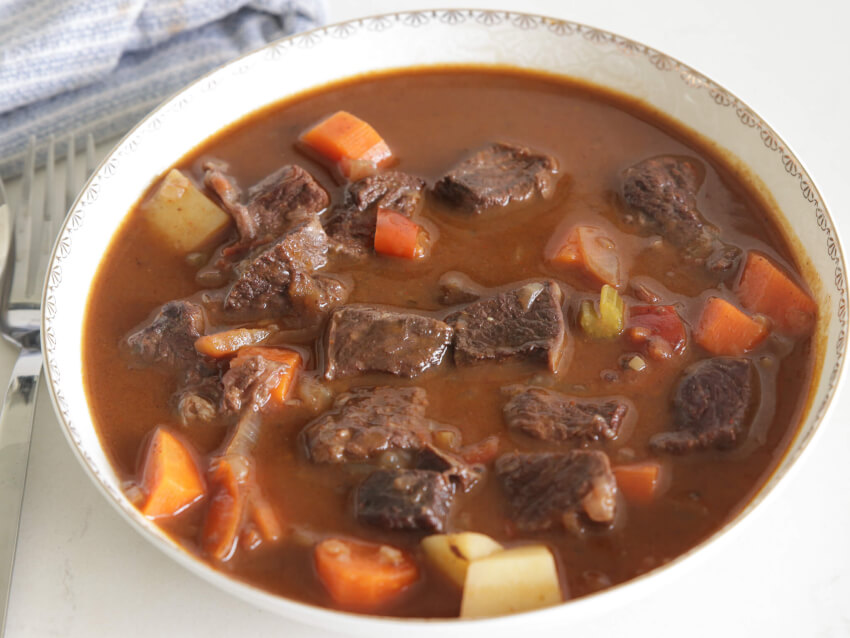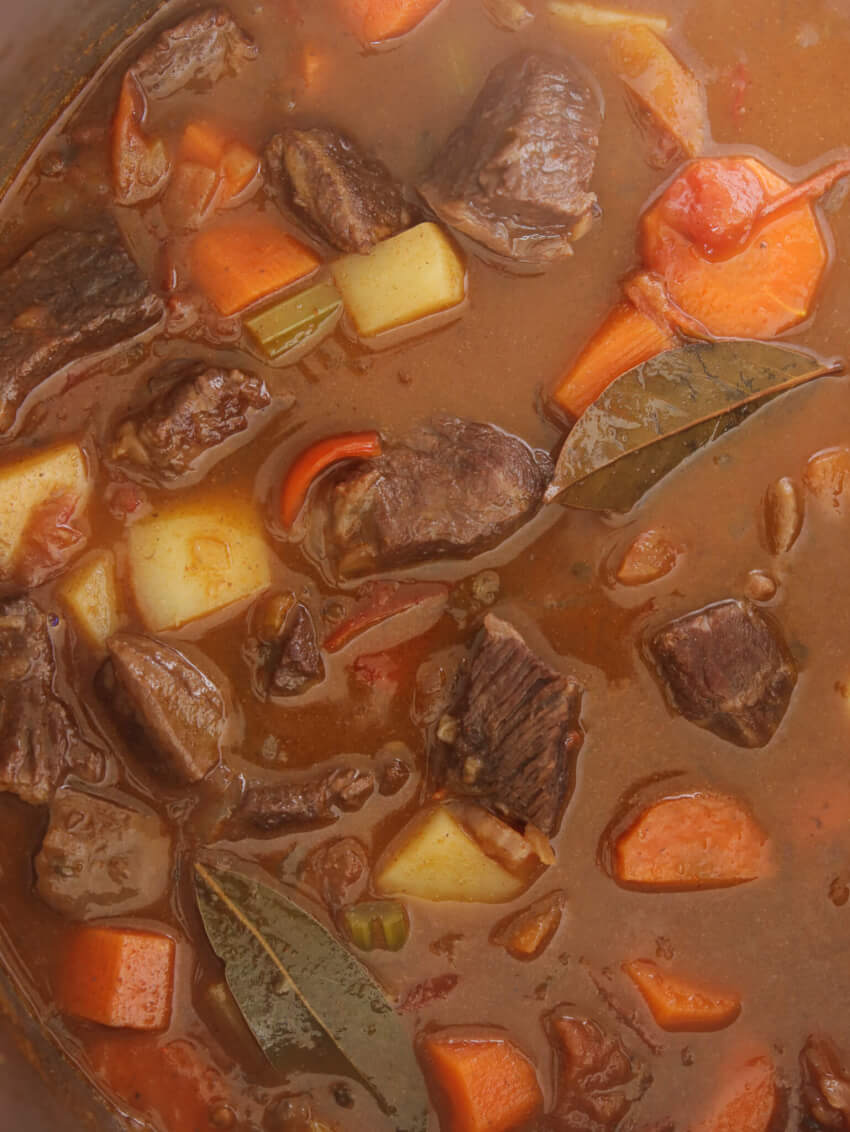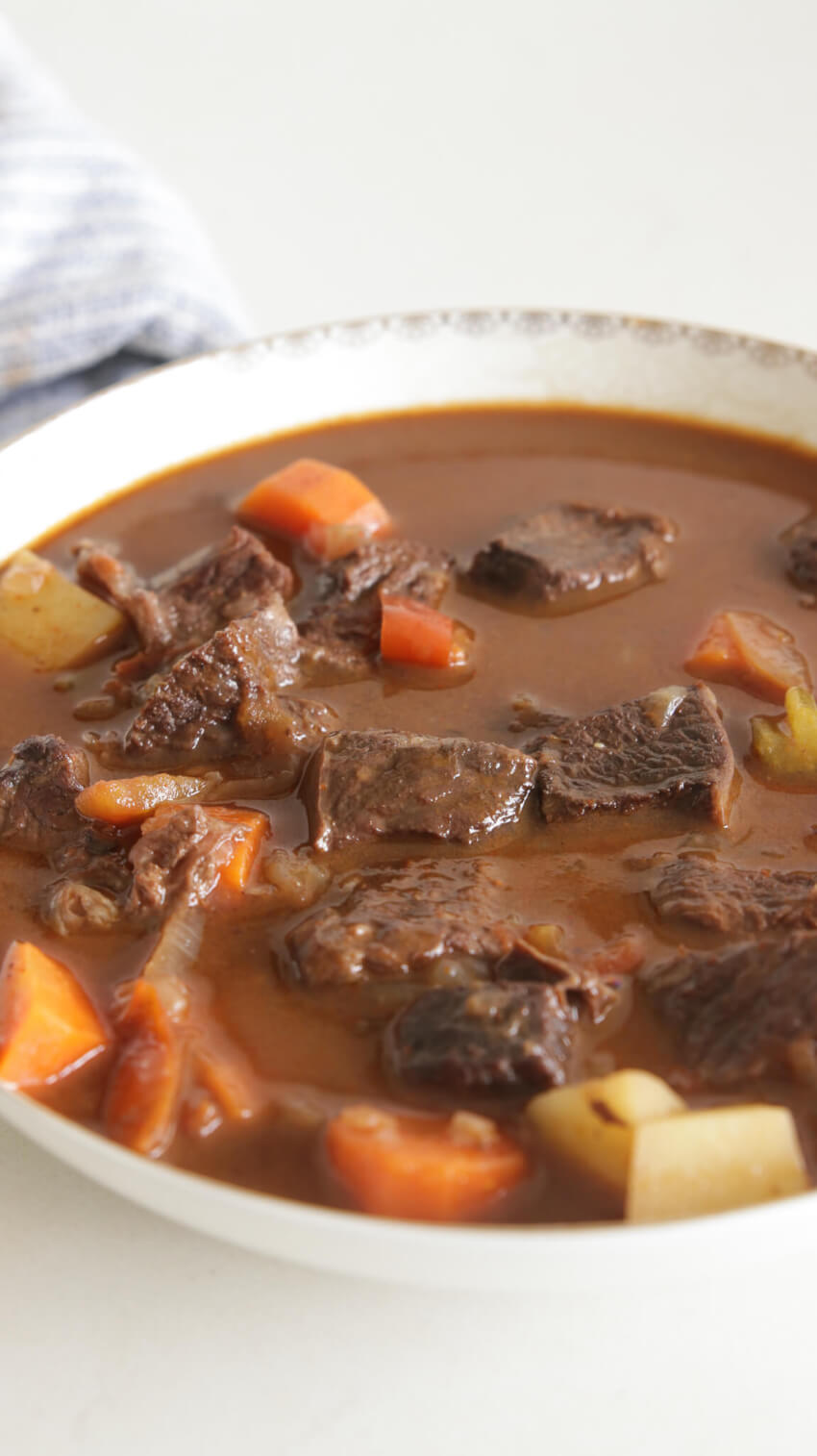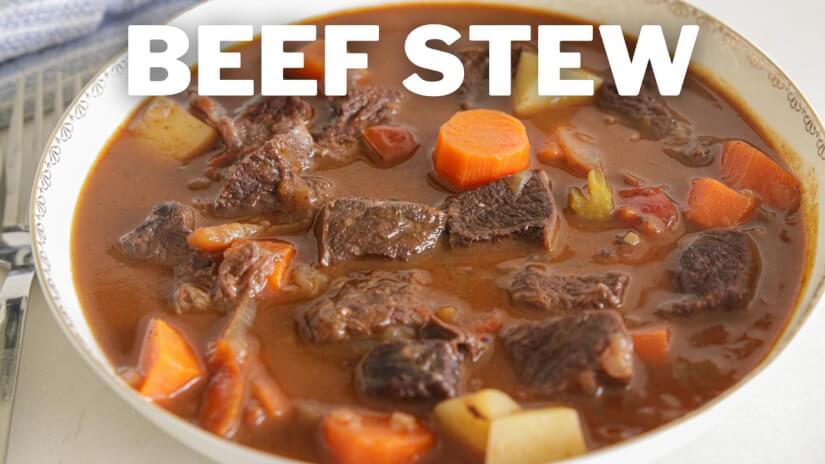TIPS TO MAKE THE BEST BEEF STEW

Making the best beef stew requires attention to detail and a few key tips to enhance the flavor, texture, and overall quality of the dish. Here are some tips to help you create a delicious beef stew:
- Choose the Right Cut of Beef: Select a tough, marbled cut of beef, such as chuck, brisket, or short ribs. These cuts become tender and flavorful when slow-cooked in a stew.
- Brown the Meat: Before adding the beef to the stew, brown it in hot oil. This step caramelizes the meat's surface, adding depth and richness to the stew's flavor.
- Sauté Aromatics: Sauté onions and garlic until they become soft and fragrant. This builds a flavorful base for the stew.
- Use Homemade or Quality Store-Bought Broth: If you're not making your own broth, choose a high-quality store-bought beef broth or stock for the best flavor.
- Add Flavorful Herbs and Spices: Consider using herbs like thyme, rosemary, and bay leaves to enhance the stew's aroma and taste. Be cautious with strong spices, as they can overpower the dish.
- Season and Layer Flavors: Season the stew throughout the cooking process, starting with seasoning the meat before browning, and then season the vegetables and liquid. Seasoning at different stages builds layers of flavor.
- Control the Liquid: Use a combination of broth and water to control the stew's consistency. Don't add too much liquid initially; you can always add more later if needed.
- Cut Vegetables Uniformly: Cut vegetables, like carrots and potatoes, into uniform sizes to ensure even cooking.
- Simmer Slowly: Allow the stew to simmer at a low, steady heat. This slow cooking process helps tenderize the meat and meld the flavors. Use a heavy pot with a tight-fitting lid to retain moisture.
- Skim the Fat: If you notice excess fat or impurities rising to the surface, skim them off during the cooking process for a cleaner and less greasy stew.
- Taste and Adjust: Taste the stew as it cooks and adjust the seasoning as needed. Adding a pinch of salt or a dash of acid (like a squeeze of lemon juice) can brighten the flavors.
- Add Vegetables at the Right Time: Add vegetables like carrots and potatoes later in the cooking process to prevent them from becoming mushy. Simmer until they're tender but still hold their shape.
- Rest Before Serving: Allow the stew to rest for a few minutes after cooking to let the flavors meld. This can improve the overall taste.
- Garnish: Consider garnishing with fresh herbs, such as parsley or chives, just before serving for a burst of freshness.
- Make It Ahead: Beef stew often tastes even better the next day, so consider making it in advance and reheating for a meal.
- Customize Your Stew: Feel free to personalize your beef stew by adding other vegetables, like peas or mushrooms, and experimenting with different seasonings to suit your taste.
HOW TO STORE BEEF STEW?

Storing beef stew properly is essential to maintain its quality and safety. Here are the steps to store beef stew:
- Cool the Stew: Allow the beef stew to cool to room temperature before storing it. This helps prevent condensation inside the storage container, which can lead to spoilage.
- Portioning: Divide the stew into smaller portions if you don't plan to consume it all at once. This makes it easier to reheat only what you need, preserving the rest for later.
- Storage Containers: Use airtight containers or airtight freezer bags. Ensure that the containers are specifically designed for freezer use to prevent freezer burn. Leave some headspace in the container to allow for expansion as the stew freezes.
- Label and Date: Label the containers with the date when the stew was prepared. This helps you keep track of how long it has been in the freezer or refrigerator.
- Refrigerator Storage: If you plan to consume the stew within a few days, store it in the refrigerator. It can be kept in the fridge for up to 3-4 days. Make sure the stew is in an airtight container.
- Freezer Storage: For longer-term storage, place the airtight containers in the freezer. Beef stew can typically be frozen for 2-3 months without a significant loss of quality, although it may still be safe to eat beyond this time.
- Thawing: When you're ready to use frozen beef stew, it's best to thaw it in the refrigerator. This gradual thawing method ensures that the stew maintains its texture and flavor. Depending on the portion size, it may take a few hours to a day to thaw completely.
- Reheating: Reheat the beef stew in a saucepan on the stove over low to medium heat. Stir occasionally to prevent sticking and ensure even heating. Alternatively, you can use a microwave, but be cautious not to overcook, as it can cause the meat to become tough.
- Check for Quality: Once thawed and reheated, check the stew for any signs of spoilage. If it smells off, has an unusual color, or has an off-putting texture, it's best not to consume it.
- Discard if Unsafe: If you're unsure about the safety or quality of the stew, it's better to discard it. It's not worth the risk of consuming spoiled food.
By following these storage guidelines, you can enjoy your beef stew over an extended period while maintaining its flavor and safety. Proper storage techniques help prevent food waste and ensure that your stew remains delicious when you're ready to enjoy it.
HOW TO MAKE BEEF STEW WITH CARROTS & POTATOES

A hearty beef stew is a comforting and filling dish that brings together a medley of ingredients, each contributing its unique qualities to create a harmonious and flavorful meal. Let's explore what each ingredient brings to the stew:
- Beef Stew Meat: The star of the dish, the beef stew meat provides a rich, meaty flavor and becomes tender and succulent during the slow cooking process. It adds the protein base to the stew, making it a hearty and satisfying meal.
- Vegetable Oil: Used for browning the meat, vegetable oil helps create a deep, flavorful crust on the beef, enhancing the overall taste and texture of the stew.
- Onion: Onions add a sweet and savory depth of flavor to the stew. They soften and become translucent during cooking, becoming a key element in the stew's aromatic base.
- Garlic: Garlic, with its pungent aroma and flavor, elevates the stew's savory notes. It complements the onions and the beef, adding a delicious complexity.
- Beef Broth: Beef broth serves as the stew's liquid base, infusing it with a rich, savory essence. It helps keep the meat tender and contributes to the stew's overall meaty character.
- Water: Water is added to the broth to create the right consistency for the stew. It ensures the stew doesn't become too thick as it simmers, allowing all ingredients to meld together.
- Carrots: Carrots bring a touch of natural sweetness and a vibrant color to the stew. They also provide a pleasant textural contrast, remaining firm yet tender after cooking.
- Potatoes: Potatoes are a hearty addition, contributing substance and a creamy texture to the stew. They absorb the flavors of the broth and the meat, making each bite satisfying.
- Bay Leaves: Bay leaves infuse the stew with subtle herbal notes and add a hint of earthiness. They are removed before serving, leaving behind a nuanced flavor.
- Dried Thyme: Thyme lends an earthy, slightly minty and lemony aroma, enhancing the overall herbaceous quality of the stew.
- Salt and Pepper: These seasonings are fundamental for enhancing all the flavors in the stew. Salt balances the sweetness of the vegetables and brings out the savory aspects, while pepper adds a touch of warmth and spiciness.
- All-Purpose Flour (optional): If used for thickening, flour contributes to the stew's texture, creating a richer, more substantial consistency.
Each ingredient plays a specific role in the symphony of flavors and textures within the beef stew. The result is a comforting and satisfying dish, where the ingredients come together to create a well-balanced, savory, and delicious meal that warms both body and soul.
WHAT BEEF CUT IS THE BEST FOR STEW?
The best beef cuts for stew are typically those that are tough and contain a good amount of connective tissue, as these cuts become tender and flavorful when slow-cooked in a stew. Some of the best cuts for stewing include:
- Chuck: Chuck roast or chuck stew meat is one of the most popular choices for stew. It's a well-marbled cut from the shoulder, and it has a great balance of meat and fat, which adds richness and flavor to the stew.
- Brisket: Beef brisket is another excellent option for stew. It's a tough cut that benefits from slow cooking, resulting in a tender, flavorful stew.
- Round: Bottom round or top round are lean cuts from the rear leg of the cow. While they're leaner than chuck or brisket, they can be used for stewing if you prefer a lower-fat option. However, they may require a slightly longer cooking time.
- Short Ribs: Beef short ribs are flavorful and well-suited for stewing. They have a good amount of fat and connective tissue that makes them tender and tasty when cooked in a stew.
- Shank: Beef shank is another option, and it contains a bone with marrow, which adds richness to the stew. It's a tougher cut that benefits from slow, moist cooking.
- Plate: Plate beef is also a suitable choice for stew. It's cut from the belly area and contains a good amount of marbling, which enhances the flavor of the stew.
When making beef stew, it's a good practice to sear the meat before adding it to the stew. This helps develop a rich, browned flavor on the surface of the meat. Additionally, remember that the cooking method, such as slow braising or simmering, is crucial for breaking down the tough fibers and making the stew tender and flavorful.
- 1-2 tablespoons Oil
- 1½ (700g) Stewing beef, cut into chunks
- Salt to taste
- Pepper to taste
- 2 Onions, roughly chopped
- 1 Red bell pepper, diced
- 3 Tomatoes, chopped
- 3 garlic cloves, minced
- 1 tablespoon Sweet paprika
- 1 teaspoon Cumin
- 1 teaspoon Dried thyme
- 1 tablespoon Tomato paste
- 1 cup (240ml) red wine (optinal)
- 4-5 cups Beef stock/chicken stock/water
- 2 Bay leaves
- 1 Celery stalk, chopped
- 3 Carrots, cut into chunks
- 2 Potatoes, cut into chunks
- In a large pot heat oil, add beef chunks, season with salt and pepper and brown them, about 6-7 minutes. Remove the beef from the pot and add chopped onions. Cook and golden. Add bell pepper and cook for 3-4 minutes. Add chopped tomatoes, minced garlic and cook for 3-4 minutes.
- Put the beef back into the pot, add tomato paste, season with the spices and mix well.
- Pour in red wine and deglaze (cook until reduced by half). Add beef stock and bay leaves.
- Cover the pot, reduce the heat to low and cook for 90 minutes.
- After 90 minutes add celery, carrots and potatoes and cook for another 20-30 minutes.
- Serve!
Notes:
- If you prefer thinner stew, add more liquids. If you prefer thicker stew, add less liquids.
- Instead of wine you can use beef stock/chicken stock/water.
Join our newsletter for free recipes, cooking tips, video recipes and special offers









Your email address will not be published